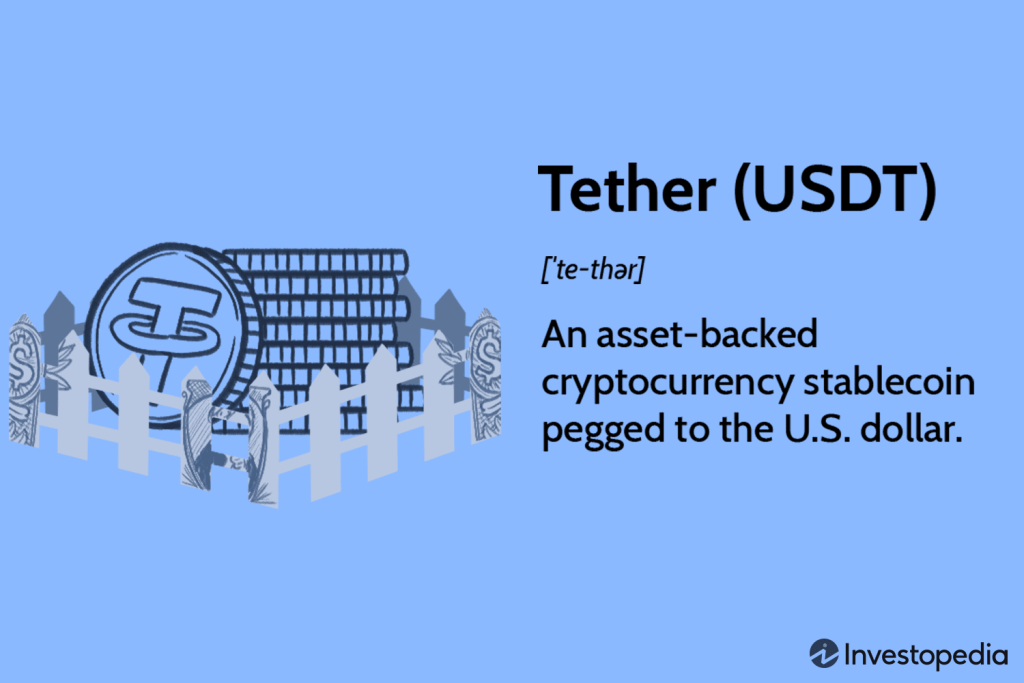- Hook or attention-grabbing statement
Cryptocurrency enthusiasts around the world have long been intrigued by the enigmatic acronym “USDT.” It’s a term that frequently pops up in discussions, news articles, and market analyses, but many remain perplexed about what exactly USDT stands for and how it fits into the broader world of digital currencies.
- Background information on USDT
USDT, or Tether, is a cryptocurrency that has gained significant prominence in the crypto ecosystem. Launched in 2014, it has become one of the most widely used stablecoins in the market. A stablecoin, as the name suggests, is designed to maintain a stable value by pegging it to a reserve of assets, typically fiat currencies like the US dollar. USDT, in particular, is known for its purported 1:1 backing with the US dollar, aiming to provide a reliable digital representation of traditional money in the world of blockchain and decentralized finance (DeFi).
- Full form of USDT
USDT stands for “Tether.” Tether is a type of cryptocurrency referred to as a stablecoin. The “T” in USDT essentially represents its connection to the US dollar, as it is designed to maintain a stable value by being pegged to a reserve of traditional fiat currencies, primarily the US dollar. In essence, each USDT token is supposed to be backed by one US dollar held in reserve.
- History and origins
Tether, or USDT, was introduced in 2014 by a company named Tether Limited. The founders of Tether Limited envisioned it as a way to bridge the gap between the traditional financial system and the emerging world of cryptocurrencies. The idea was to provide a digital representation of fiat currency that could be easily transferred and used within the cryptocurrency ecosystem while maintaining a stable value.
Initially, Tether operated on the Bitcoin blockchain using the Omni Layer protocol, but it has since expanded to operate on multiple blockchain networks, including Ethereum (as ERC-20 tokens) and Tron. This diversification allowed Tether to reach a wider audience and become a fundamental component of many cryptocurrency exchanges and trading pairs.
- Importance in the cryptocurrency world
Tether, or USDT, holds significant importance in the cryptocurrency world for several reasons:
Stability: USDT is designed to be a stablecoin, which means it aims to minimize the volatility commonly associated with cryptocurrencies. This stability makes it a popular choice for traders and investors who want to park their funds in a digital asset without worrying about price fluctuations.
Liquidity: Tether is widely accepted on cryptocurrency exchanges and platforms, providing liquidity and a common trading pair for various cryptocurrencies. It serves as a safe haven during times of high market volatility.
Arbitrage: Traders use USDT as a means of quickly moving funds between different exchanges to take advantage of price differences (arbitrage opportunities) since it is faster to transfer USDT than fiat currency.
Regulatory Compliance: Tether has often claimed to be compliant with regulations, which has made it appealing to institutional investors and businesses looking for a stable digital asset to interact with the crypto market.
- Comparison with Bitcoin, Ethereum, and other popular cryptocurrencies
USDT differs significantly from cryptocurrencies like Bitcoin and Ethereum in several ways:
Stability vs. Volatility: The primary distinction is that USDT is a stablecoin designed to maintain a stable value by being pegged to a reserve of traditional fiat currency (e.g., the US dollar), whereas Bitcoin and Ethereum are highly volatile cryptocurrencies with prices subject to significant fluctuations.
Store of Value vs. Medium of Exchange: Bitcoin and Ethereum are often seen as “store of value” assets or digital gold, while USDT is more commonly used as a “medium of exchange” or a means to transact within the cryptocurrency ecosystem.
Utility: Bitcoin and Ethereum have broader use cases beyond being a means of exchange. Ethereum, for instance, is known for its smart contract capabilities, allowing developers to build decentralized applications (DApps) on its blockchain. USDT, on the other hand, primarily serves as a digital representation of fiat currency for trading and transferring value.
Blockchain Technology: While Bitcoin and Ethereum each have their own blockchain networks, USDT exists on multiple blockchains, including Ethereum, Tron, and others. This versatility allows users to choose the blockchain that suits their needs best.
- Use cases and advantages of USDT
Stability: The primary use case of USDT is to provide stability within the volatile cryptocurrency market. Traders often use it as a hedge against market fluctuations, allowing them to preserve the value of their assets during periods of uncertainty.
Transfer of Value: USDT is used for quick and low-cost cross-border transfers of value. Users can send USDT tokens across borders without the delays and fees associated with traditional banking systems.
Arbitrage: Traders leverage USDT for arbitrage opportunities, buying low on one exchange and selling high on another. Its stability makes it an ideal intermediary for these quick transactions.
Access to Cryptocurrency Markets: USDT serves as an entry point for many traders who want to access the cryptocurrency markets without directly dealing with fiat currency. It provides a bridge between the crypto world and traditional financial systems.
Decentralized Finance (DeFi): USDT is also used in the DeFi space, where it can be lent, borrowed, and used as collateral for various financial services and decentralized applications.
- Market performance and adoption
USDT has witnessed substantial adoption and market growth over the years. It consistently ranks among the top cryptocurrencies by market capitalization, often trading with a higher daily volume than Bitcoin. This widespread adoption can be attributed to its stability and utility within the cryptocurrency ecosystem.
Furthermore, USDT’s availability on multiple blockchain networks has expanded its reach, making it accessible to a broader audience of users and developers. Its adoption in DeFi platforms and applications has also contributed to its popularity, as it provides a stable foundation for DeFi services.
Despite its success, USDT has faced regulatory challenges and controversies related to its transparency and the actual backing of its tokens with fiat reserves. These issues have led to increased scrutiny from regulators and a growing demand for greater transparency in the stablecoin industry.
To answer the question what does usdt stand for USDT stands apart from traditional cryptocurrencies like Bitcoin and Ethereum due to its stable value and primary use as a medium of exchange within the cryptocurrency world. Its success lies in its stability, liquidity, and versatility, making it a crucial component of the crypto market. However, it also faces ongoing challenges related to regulatory compliance and transparency.

